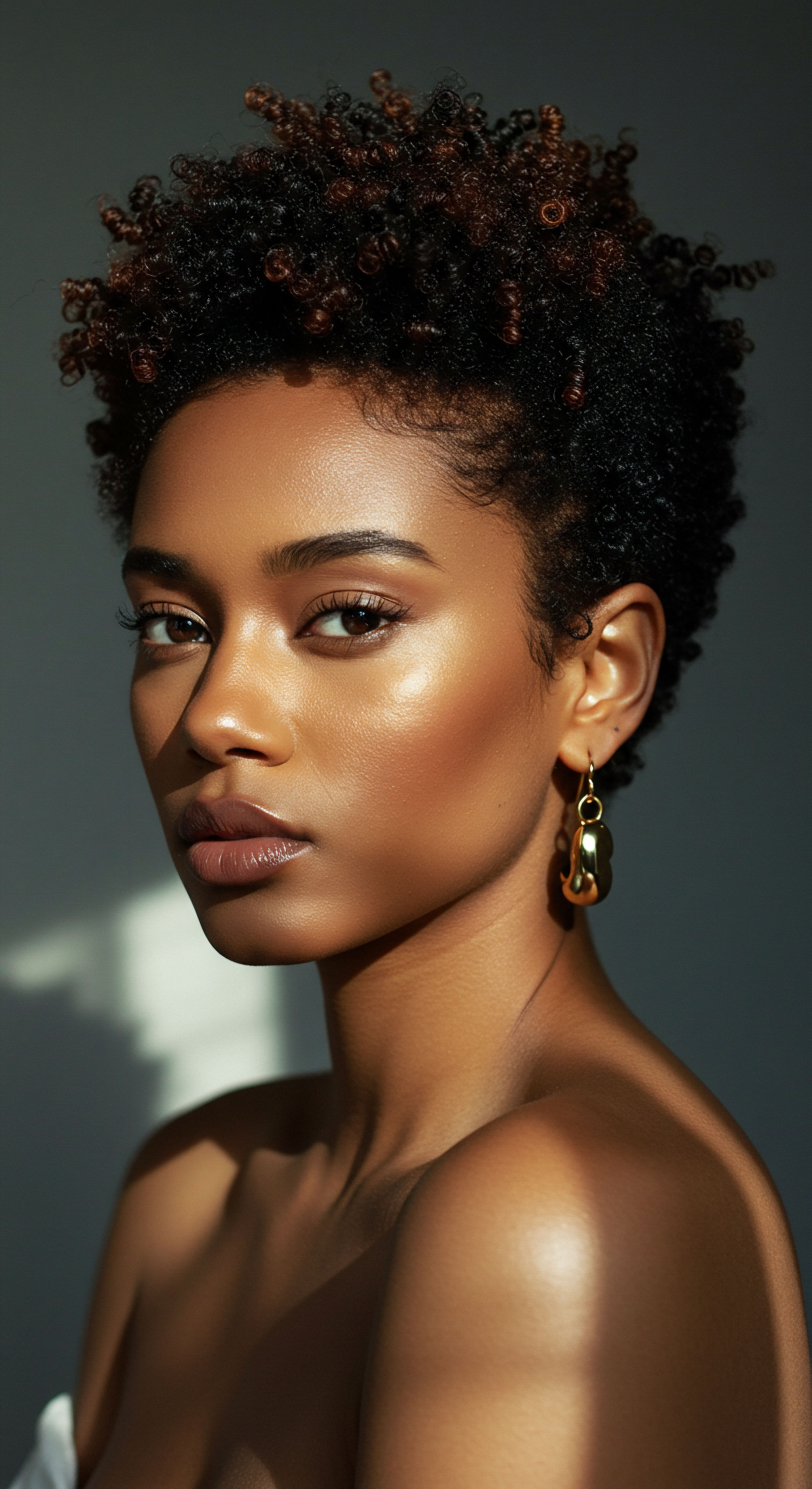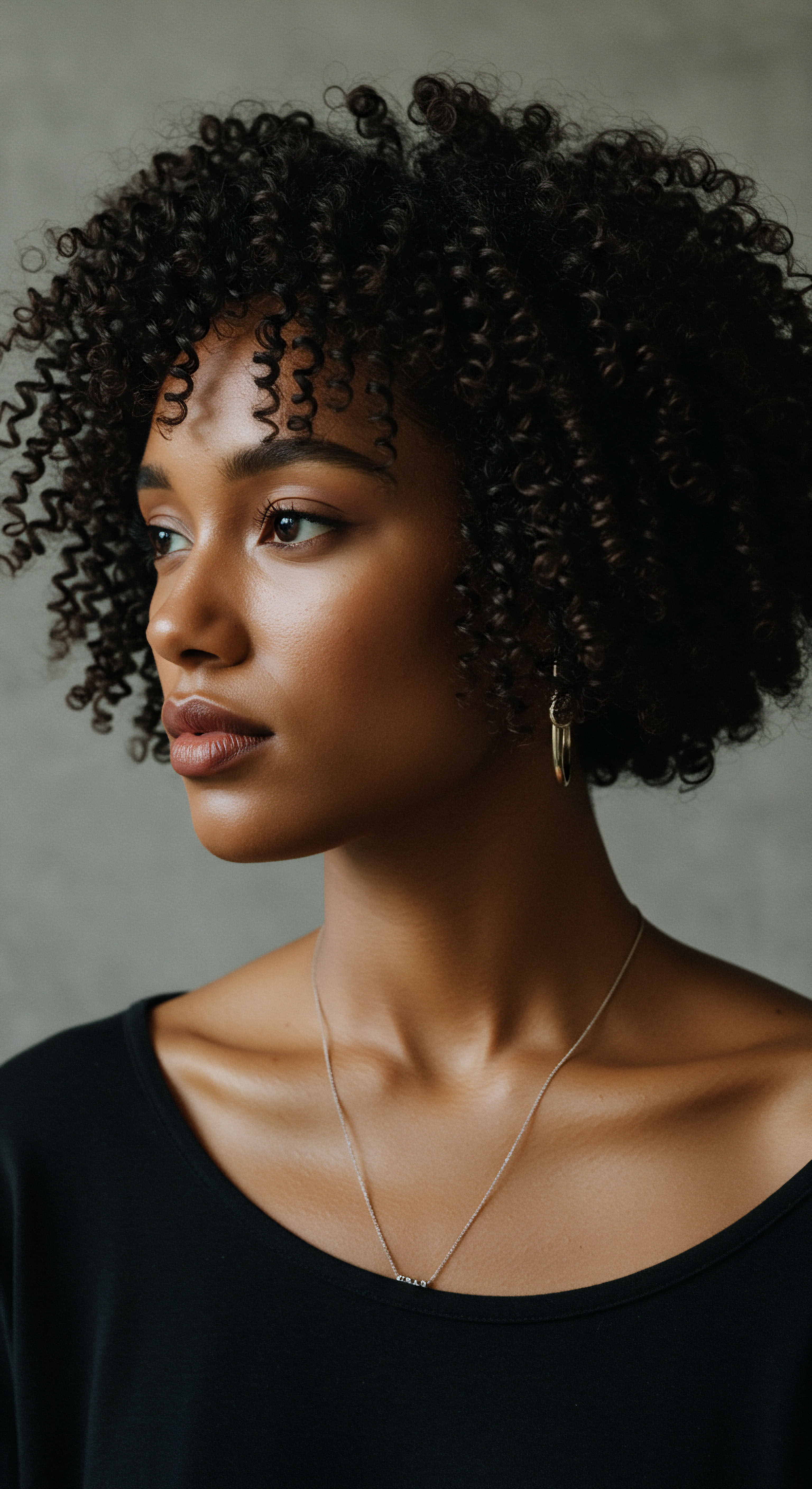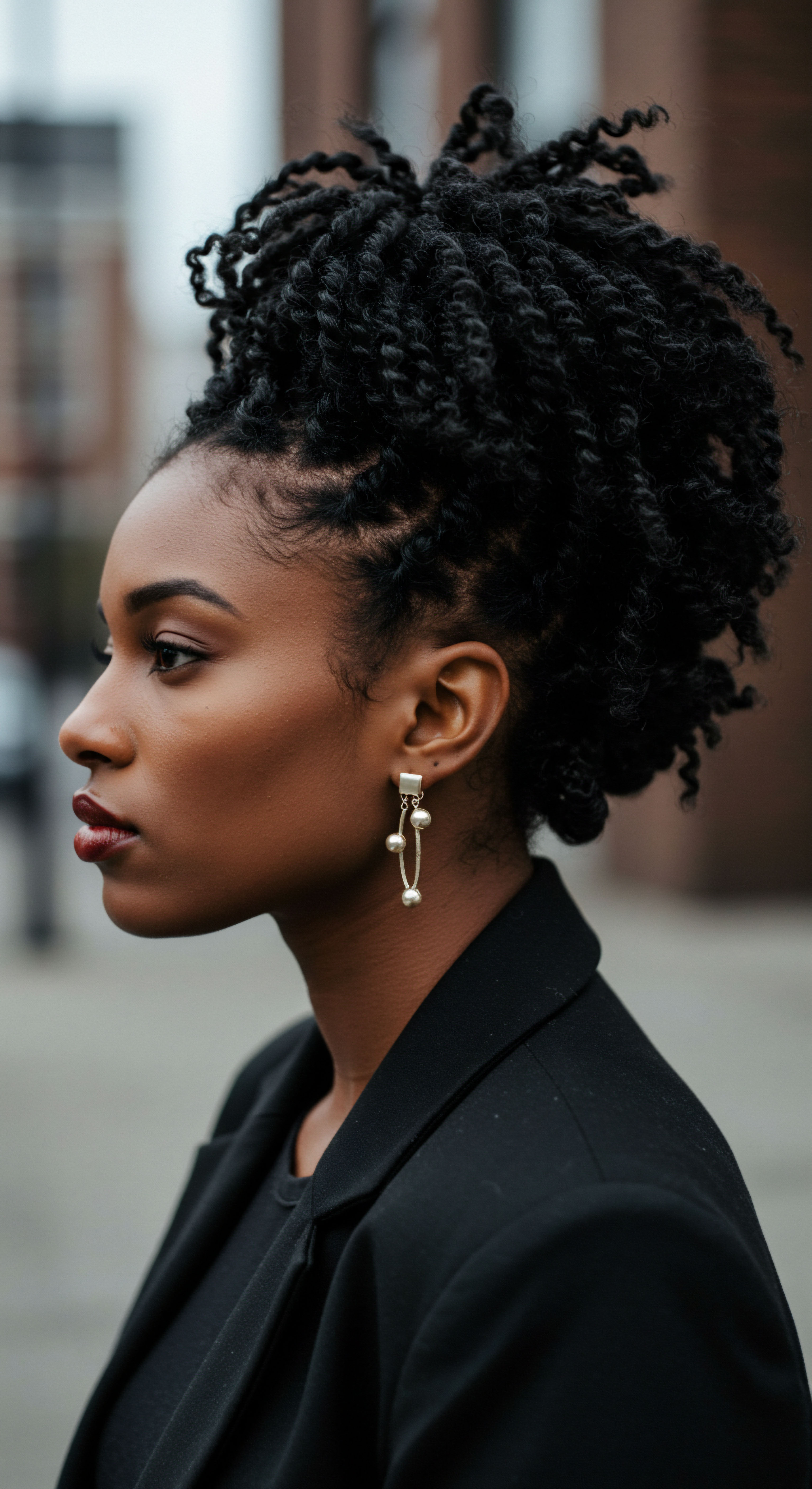
Roots
The whisper of silk against skin, the vibrant sweep of a printed cloth, or the comforting weight of a wrap carefully placed—for many, a head covering transcends mere adornment. It is a language spoken without words, a statement of identity, heritage, or spiritual devotion. Yet, beneath these beautiful expressions lies a delicate landscape ❉ the scalp, a vital foundation for hair’s well-being. This intimate relationship, often centuries old, prompts a thoughtful query ❉ Can cultural head wraps, in their long-standing presence, truly influence scalp health over time?

The Scalp’s Living Layer
Our scalp is more than a surface; it represents a living ecosystem, a dynamic environment where hair growth begins. It acts as a protective barrier, shielding the underlying skull and brain from external aggressors. This skin, distinct from other body areas, boasts a higher density of hair follicles and sebaceous glands. These tiny glands produce sebum, a natural oil that lubricates the hair and skin, forming a part of the scalp’s protective mantle.
The health of this barrier, its moisture levels, and its natural pH balance, are paramount for the vibrant growth of hair strands that emerge from within. Any disruption to this finely tuned system can reverberate through the hair, affecting its strength, appearance, and overall vitality.
The scalp, a vibrant ecosystem, forms the fundamental groundwork for healthy hair.

Hair’s Deep Anchors
Each hair strand, a slender protein filament, originates from a specialized structure nestled deep within the skin ❉ the hair follicle. These microscopic powerhouses are responsible for the cyclical production of hair. They possess their own intricate network of blood vessels and nerves, supplying the necessary nutrients and signals for growth. The follicle’s shape and orientation determine the curl pattern of the hair, explaining the unique textures observed across diverse populations.
When the hair follicle experiences stress, whether from tension, lack of air, or environmental shifts, its ability to perform its function can diminish. Over time, persistent strain can lead to significant changes in hair quality or even loss, underscoring the profound connection between the visible hair and its hidden roots.

Ancestral Practices and Head Coverings
Across continents and generations, head wraps hold deep cultural resonance. From the intricate gele of West Africa to the elegant turbans of South Asia, these coverings tell stories of tradition, social standing, and spiritual adherence. They serve practical purposes too, offering protection from the sun, dust, and cold. For textured hair, head wraps often function as a form of protective styling, minimizing manipulation and shielding delicate strands from environmental elements.
Understanding this dual role—as both a cultural marker and a hair care tool—is central to comprehending their potential impact on scalp health. The wisdom of these ancient practices, passed down through oral tradition and lived experience, often holds subtle keys to maintaining balance, even as modern understanding brings new insights to light.

Ritual
The act of wrapping hair, whether for daily wear or special occasions, is a ritual imbued with intention. It is a moment of care, a gesture of identity, or a practical step in a hair care regimen. For those with textured hair, head wraps are often considered a protective style, designed to shield delicate strands and promote length retention.
Yet, even the most cherished rituals warrant careful consideration, particularly when the long-term well-being of the scalp is at stake. How can we ensure these beautiful practices support, rather than hinder, the health of the scalp beneath?

Selecting Optimal Fabrics
The choice of material for a head wrap carries substantial weight for scalp and hair health. Fabrics vary widely in their breathability and moisture-wicking properties. Natural fibers like silk and satin are frequently lauded for their smooth surfaces, which minimize friction against hair strands. This reduction in friction helps prevent breakage and preserves the hair’s natural moisture, which can be particularly beneficial for textured hair types prone to dryness.
These materials also allow for better air circulation compared to denser fabrics. In contrast, materials like cotton, while comfortable, can absorb moisture from the hair and scalp, potentially leading to dryness over prolonged contact. Densely woven synthetic fabrics might trap heat and humidity, creating an environment less than ideal for scalp equilibrium. A conscious selection of material, prioritizing smooth, breathable options, forms a foundational step in promoting scalp well-being under wraps.

Mindful Placement and Tension
The way a head wrap is secured profoundly influences its effect on the scalp. A common pitfall lies in applying excessive tension, particularly around the hairline, temples, and nape of the neck. These areas, often subject to the most pulling, are highly susceptible to stress. Over time, persistent pressure can compromise the hair follicles, leading to thinning or loss.
The goal is to achieve a secure fit that holds the wrap in place without causing discomfort or strain. This often involves distributing the fabric’s pressure evenly across the head, rather than concentrating it in one area. Understanding the hair’s delicate nature and avoiding overly tight styles are essential steps in maintaining the integrity of the hair roots and the surrounding scalp tissue.
Conscious material selection and gentle wrapping methods are central to preserving scalp vitality.

Cleansing Beneath the Covering
Regular cleansing of the scalp remains a cornerstone of hair health, regardless of whether hair is covered. Head wraps can create a microclimate that, if not properly managed, can become a breeding ground for concerns. Sweat, sebum, and product residue can accumulate on the scalp, potentially leading to irritation, itching, or even microbial overgrowth. Establishing a consistent cleansing routine, using gentle, sulfate-free cleansers designed for scalp balance, is vital.
This ensures that the scalp remains clean and clear, allowing follicles to breathe and function optimally. Proper rinsing and drying of the hair and scalp before re-covering are also critical steps to prevent dampness, which can encourage undesirable microbial activity.

Styling for Air Circulation
The style chosen for hair beneath a head wrap plays a significant part in scalp health. Styles that allow for some air circulation, rather than completely flattening the hair against the scalp, are often preferable. Loose braids, gentle twists, or a simple bun placed at the crown can help prevent excessive compression and promote airflow. These methods also reduce friction between the hair and the wrap’s material.
When hair is consistently pulled taut or compressed, it can impede the natural flow of air and moisture, contributing to an environment that may not support optimal scalp conditions. Prioritizing loose, unrestrictive styles beneath the wrap can significantly contribute to the long-term health of the scalp and hair.

Relay
The interplay between cultural head wraps and scalp health is a complex conversation, extending beyond simple care practices to touch upon biological susceptibilities, environmental factors, and even the subtle whispers of societal expectation. It is a dialogue where tradition meets trichology, inviting a deeper understanding of how these cherished customs might, at times, pose silent challenges to the scalp’s delicate balance.

When Adornment Meets Ailment ❉ Tension’s Hidden Cost
For generations, head wraps have served as protective shields, yet the manner of their wear can sometimes introduce an unintended adversary ❉ tension. The consistent, often subtle, pulling on hair follicles, particularly along the hairline and the sides of the head, can lead to a condition known as traction alopecia. This form of hair loss arises from repetitive strain on the hair roots, causing inflammation and, over time, permanent damage to the follicle. While any hair type can experience traction alopecia, certain hair structures exhibit a heightened susceptibility.
A notable prevalence of traction alopecia, affecting approximately one-third of women of African descent, has been observed, often linked to consistent high-tension hairstyles, including certain head coverings. This susceptibility is partly attributed to the unique morphology of textured hair follicles, which tend to be curved, making them more prone to damage from pulling forces. The persistent tension, even if seemingly mild day-to-day, accumulates, leading to a gradual recession of the hairline, often accompanied by small, pimple-like bumps and scalp soreness in earlier stages.
This silent progression can be particularly concerning because individuals may not perceive the damage until it is well-advanced, sometimes even years after the initiating practices began. The significance of this lies not in discouraging cultural practices, but in fostering awareness and adaptive strategies that honor heritage while safeguarding scalp vitality.

The Scalp’s Microbial World Under Wraps
Beneath the surface of the scalp lies a bustling community of microorganisms—bacteria, fungi, and yeasts—collectively forming the scalp microbiome. This intricate ecosystem plays a crucial role in maintaining scalp health, influencing everything from pH balance to immune responses. When head wraps are worn for prolonged periods, especially in warm or humid climates, they can create an occlusive environment. This enclosed space can alter the natural balance of the microbiome, leading to an overgrowth of certain microbes.
For example, the fungus Malassezia, a normal resident of the scalp, can proliferate in humid conditions, contributing to issues like dandruff and seborrheic dermatitis. More concerning are instances of fungal infections, such as Tinea Capitis, which can be exacerbated by trapped moisture and lack of air circulation. The presence of dampness and warmth creates an ideal breeding ground, disrupting the scalp’s natural defenses and potentially leading to itching, scaling, and even hair loss.
| Microbial Shift Malassezia Overgrowth |
| Potential Scalp Condition Dandruff, Seborrheic Dermatitis |
| Contributing Factors Under Wraps Increased humidity, trapped sebum, reduced air circulation. |
| Microbial Shift Dermatophyte Fungi Proliferation |
| Potential Scalp Condition Tinea Capitis (Ringworm) |
| Contributing Factors Under Wraps Prolonged dampness, poor hygiene, sharing headwear. |
| Microbial Shift Bacterial Dysbiosis |
| Potential Scalp Condition Folliculitis, Scalp Irritation |
| Contributing Factors Under Wraps Sweat accumulation, friction, impaired skin barrier. |
| Microbial Shift Understanding the delicate balance of the scalp microbiome is vital for maintaining its health, particularly when regularly wearing head coverings. |

Moisture Dynamics and Barrier Integrity
The skin barrier on the scalp is designed to regulate moisture and protect against irritants. When head wraps are worn, especially those made of non-breathable materials or secured too tightly, they can interfere with this delicate balance. The scalp may experience excessive sweating, leading to maceration—a softening and weakening of the skin due to prolonged exposure to moisture. This can compromise the skin barrier, making the scalp more vulnerable to external pathogens and irritants.
Conversely, some materials can wick away too much natural moisture, leaving the scalp dry and prone to flaking and itching. The ideal scenario involves a wrap that allows for appropriate ventilation while protecting the hair, helping to maintain the scalp’s natural hydration and pH levels, which typically hover in a slightly acidic range (around 4.5-5.5) to deter microbial overgrowth.
The intimate relationship between hair and scalp demands informed choices, especially when cultural practices shape daily care.

Beyond the Physical ❉ Hair Loss’s Emotional Weight
Hair loss, regardless of its cause, often carries a significant emotional and psychological weight. For individuals whose hair is deeply intertwined with their cultural identity or personal expression, conditions like traction alopecia can be particularly distressing. The experience can affect self-perception and confidence, creating a silent struggle beneath the surface of daily life.
Acknowledging this emotional dimension is crucial, as it shapes how individuals approach their hair care practices and seek solutions. The goal is not to abandon practices steeped in history, but to adapt them with knowledge, allowing cultural expression and scalp well-being to coexist harmoniously.

Navigating with Knowledge ❉ A Path to Healthier Traditions
The path to healthier scalp practices, when wearing cultural head wraps, centers on awareness and informed adjustments. This involves selecting appropriate materials, ensuring gentle application, maintaining rigorous scalp hygiene, and opting for hair styles that minimize tension and promote air circulation. It also means recognizing early signs of distress, such as persistent itching, soreness, or thinning, and seeking professional guidance when concerns arise. By understanding the science behind scalp health and integrating this knowledge with cherished cultural practices, individuals can preserve the beauty of their traditions while safeguarding the vitality of their hair and scalp for years to come.

Reflection
The journey of hair, especially textured hair, is a deeply personal one, often interwoven with stories of heritage, resilience, and self-expression. When head wraps, those vibrant symbols of culture and grace, become a part of this story, they bring with them a dialogue between ancient wisdom and modern understanding. It is a conversation that reminds us that true beauty flourishes not just in outward presentation, but in the quiet, consistent care given to the very roots of our being. May we always seek the knowledge that empowers us to honor our traditions with wellness at their core, ensuring that every strand, every follicle, tells a story of health and vibrant life.

References
- Agbai, O. & Maragh, S. (2022). Helping Patients with Traction Alopecia ❉ Basics, Treatment, and Prevention. Dermatology Times .
- Alhanshali, A. et al. (2023). Religious headwear and alopecia ❉ considerations for dermatologists. International Journal of Women’s Dermatology .
- AlJasser, A. et al. (2019). Headcover and male-pattern hair loss ❉ A cross-sectional study. Journal of Dermatology and Dermatologic Surgery, 23(2), 82-84.
- Dixon, B. (2024). Black women turning to protective styling for their hair. The Famuan .
- Gavazzoni Dias, M. F. et al. (2014). The shampoo pH can affect the hair ❉ myth or reality? International Journal of Trichology, 6(3), 95–99.
- Nurul Hidayah, R. M. et al. (2023). Evaluation of Scalp Hydration and pH Values in Hijab-Wearing and Non-Hijab-Wearing Women. International Journal of Women’s Health, 15, 1753–1759.
- Patel, D. S. (2018). Traction alopecia ❉ the root of the problem. International Journal of Trichology, 10(2), 51-53.
- Phillips, I. (2024). Black women turning to protective styling for their hair. The Famuan .
- Sánchez-Pellicer, P. et al. (2022). Comparative analysis of scalp and gut microbiome in androgenetic alopecia ❉ A Korean cross-sectional study. PLoS One, 17(12), e0278112.
- Sánchez-Pellicer, P. et al. (2023). Scalp microbiome ❉ Where research needs to go next. The Secret Life Of Skin .
- Schwartz, J. R. et al. (2015). The role of oxidative damage in poor scalp health ❉ ramifications to causality and associated hair growth. International Journal of Cosmetic Science, 37(Suppl 2), 9–15.
- Shareef, S. et al. (2023). Considerations for Preventing and Addressing Alopecia in Patients With Religious Headwear. Dermatology Times .
- Trueb, R. M. (2021). Oxidative stress and its impact on skin, scalp and hair. International Journal of Cosmetic Science, 43(Suppl 1), S9–S13.
- Wu, G. & Sun, H. (2023). Scalp Fungal Infection ❉ Symptoms, Causes, and Treatment. MAX HAIR .